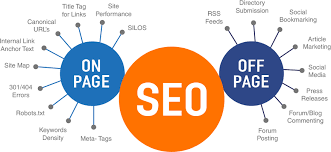
Search Engine Optimization (SEO) is a fundamental aspect of digital marketing that can significantly impact your online visibility and success. While off-site SEO strategies such as link building are crucial, on-site SEO plays an equally important role in improving your website’s search engine rankings and attracting organic traffic.
On-Site SEO, also known as on-page SEO, refers to the practice of optimizing various elements within your website to improve its search engine visibility and relevance. This includes optimizing content, meta tags, headings, images, URLs, and internal linking structures to make your site more attractive to search engines like Google.
Effective on-site SEO involves several key components that work together to enhance your website’s performance:
Implementing effective on-site SEO practices can yield a range of benefits for your website and business:
In today’s competitive digital landscape, on-site SEO is an essential component of any successful digital marketing strategy. By focusing on optimizing key elements within your website, you can enhance its visibility, attract organic traffic, and ultimately drive business growth. Invest in on-site SEO practices today to unlock the full potential of your online presence.
On-site SEO, also known as on-page SEO, refers to the process of optimizing various elements within a website to improve its search engine visibility and relevance. This includes strategically incorporating relevant keywords, creating high-quality content, optimizing meta tags and URLs, and establishing a logical internal linking structure. On-site SEO is crucial because it helps search engines understand the content and relevance of a website, ultimately leading to improved search engine rankings and increased organic traffic. By focusing on on-site SEO practices, businesses can enhance their online presence, attract more qualified leads, and establish credibility and authority in their industry.
Keyword optimization plays a crucial role in on-site SEO by influencing how search engines interpret and rank your website’s content. By strategically incorporating relevant keywords into your website’s content, meta tags, headings, URLs, and internal links, you can signal to search engines the relevance of your pages to specific search queries. Effective keyword optimization helps improve your website’s visibility in search engine results pages (SERPs) and increases the likelihood of attracting organic traffic from users actively searching for information related to those keywords. Ultimately, keyword optimization enhances the overall effectiveness of your on-site SEO efforts by aligning your content with the search intent of your target audience.
The key components of on-site SEO encompass a range of essential elements that are critical to enhancing a website’s search engine visibility and performance. These components include keyword optimization, where strategic use of relevant keywords in content helps improve search rankings; quality content creation that engages users and adds value; meticulous meta tag optimization for better click-through rates in search results; user-friendly URL structures with descriptive keywords; and logical internal linking structures that aid search engines in understanding the site’s content hierarchy. By focusing on these key components, businesses can effectively boost their online presence and attract organic traffic through improved search engine rankings.
Quality content plays a pivotal role in enhancing on-site SEO by providing valuable information to users and search engines. Search engines like Google prioritize content that is relevant, engaging, and authoritative, rewarding websites with high-quality content with better rankings in search results. By creating informative and well-structured content that incorporates relevant keywords naturally, websites can attract more organic traffic, increase user engagement, and establish credibility within their industry. Quality content not only improves the user experience but also signals to search engines that a website is a reliable source of information, ultimately boosting its on-site SEO performance.
Meta tag optimization is crucial for on-site SEO because meta tags, including meta titles and descriptions, play a vital role in communicating the relevance and content of a web page to search engines. By strategically optimizing meta tags with relevant keywords and compelling information, website owners can improve their chances of ranking higher in search engine results pages (SERPs). Meta tags not only influence click-through rates but also help search engines understand the context of a page, making it easier for them to index and rank the content appropriately. In essence, effective meta tag optimization enhances a website’s visibility, clickability, and overall SEO performance.
Internal linking plays a crucial role in on-site SEO by establishing a network of connections between pages within a website. These internal links help search engines understand the structure and hierarchy of the site, guiding them to important pages and distributing link equity effectively. By strategically implementing internal links with relevant anchor text, websites can improve user experience, increase page authority, and enhance overall search engine visibility. Internal linking also encourages users to explore more content on the site, leading to longer visit durations and lower bounce rates. In essence, internal linking is a powerful on-site SEO strategy that not only benefits search engine rankings but also enhances website usability and engagement.